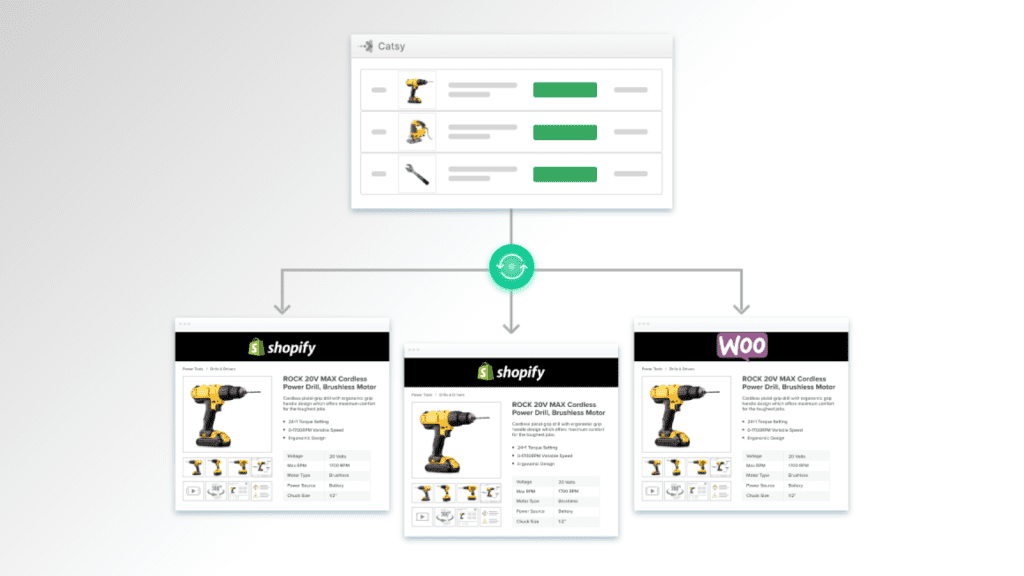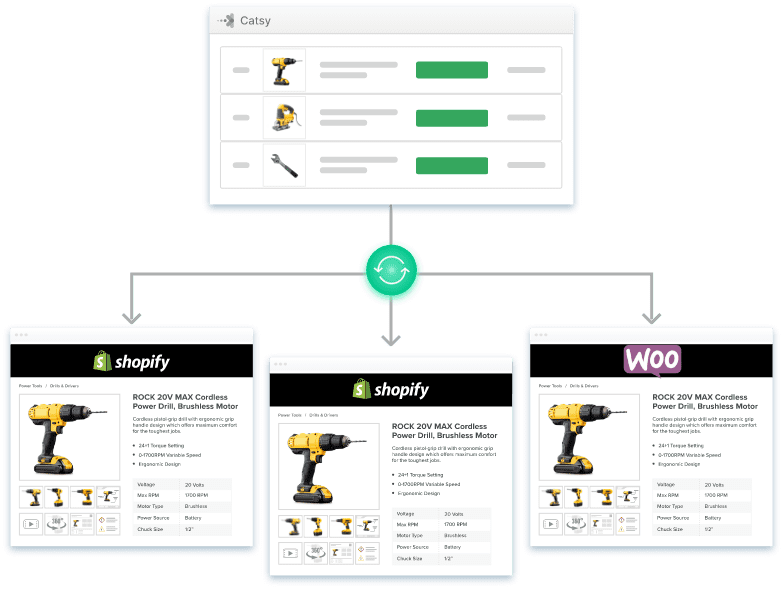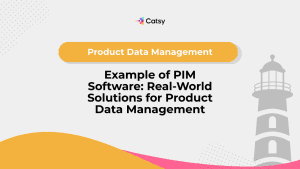Effortlessly Manage Shopify Merchants in WooCommerce Store: Tools and Best Practices

- Integrating Shopify and WooCommerce can expand your market reach and streamline operations.
- Plugins help to streamline the integration but fall back on data accuracy.
- Catsy's unified PIM and DAM platform simplifies multi-store management and ensures consistent, high-quality product data for both stores.
In this Article
Imagine you’re running a thriving Shopify store, but you’re eyeing new horizons to expand your business. Your plan? To list the same products on WooCommerce. Perhaps you aim to tap into a different customer base – bulk buyers or those seeking customizations. You’ve decided that WooCommerce’s catalog mode perfectly fits this strategy. But here’s the challenge: you want seamless synchronization of all your data – products, customers, orders – across both platforms.
On the face of it, this might seem puzzling. After all, Shopify and WooCommerce are competing e-commerce giants. In fact, Omnisend ranks Shopify first and WooCommerce third in the list of the ten best e-commerce platforms in 2024. So, why would you want to use both? The answer lies in a powerful truth: while these platforms may appear as rivals, integrating them can unlock the best of both worlds for your business.
This brings us to a critical question: Can Shopify and WooCommerce truly work together? More specifically, how can this integration enable you to manage Shopify merchants within your WooCommerce store? It might sound complex, but it’s not only possible – it’s a game-changing strategy for expanding your product reach and streamlining your operations.
This post explores this symbiotic relationship and shows you how to harness the power of both platforms to supercharge your online business.

Why Integrate Shopify and WooCommerce?
The best place to start this discussion is by addressing whether Shopify and WooCommerce can work together. The short answer is yes. Thanks to several tools and plugins, you can connect the two platforms and synchronize products, categories, and orders.
But why?
1. Expanding market reach
We noted earlier that Shopify and WooCommerce are platforms that merchants use to showcase their products online. The most differentiating factor is that Shopify handles all the technical aspects of an online shop, including hosting, maintenance, and security. In contrast, WooCommerce is a plugin that turns a WordPress website into an e-commerce site and requires you to host, maintain, and secure the store.
From the differences, one can already tell that WooCommerce and Shopify each have a unique ecosystem and user base. Therefore, integrating the platforms offers a powerful opportunity to broaden your customer base.
Listing the same products on both platforms allows you to target different types of buyers who may have distinct preferences. Shopify might attract customers who prefer its streamlined interface and modern checkout features. On the other hand, WooCommerce’s flexibility and catalog mode may appeal to bulk buyers or those looking for customizable options.
Synchronizing the platforms showcases your products to a broader audience, helping you capture new market segments without managing entirely separate inventories. This strategic expansion ensures that you maximize your potential for growth by leveraging the strengths of both platforms.
2. Unified management of multi-channel sales
A company that wants to integrate Shopify and WooCommerce often has a multi-channel sales strategy. Perhaps the reason for bringing the two platforms much closer is to streamline operations. And guess what? This is precisely one of the upsides of integrating the e-commerce platforms.
The integration allows you to manage inventory across both platforms from a single dashboard. This means real-time updates across all sales channels, reducing the risk of overselling and ensuring accurate stock levels.
You can also manage orders from Shopify and WooCommerce in one place. This unified view simplifies order fulfillment, making tracking and processing orders easier regardless of which platform they originated from.
The bottom line is that instead of juggling separate dashboards, product inventories, and order processes, the integration lets you do one task just once. This means that updates made in one store—whether product descriptions, inventory levels, or order statuses—are automatically reflected in the other. One can conclude that the most significant benefit of the unification is boosting efficiency.
3. Migrating product catalogs from one platform to another
So far, the primary assumption is that you want to use both Shopify and WooCommerce to extend the product reach and leverage each platform’s strengths. However, that is not always the case.
Suppose your online store is built on WordPress via the WooCommerce plugin, but you would like to switch to Shopify. In that case, you must migrate the product information and digital assets from WooCommerce to Shopify. In other words, you need to integrate the two platforms to create a pathway for content transfer.
As you will see later, three main options exist for migrating the content. First, you can use the export and import features – export content from WooCommerce and then import it into Shopify. The challenge here is to avoid errors because each platform has unique quality standards and information architecture.
The second option is to use plugins, and they’re plenty. Plugins follow the first approach but are designed to automate most of the process. But as you will learn, this method has various limitations, including the fact that your business operations will depend on a third-party developer to function seamlessly. There is also the small matter of expenses because some plugins charge for specific features, which might be crucial to the migration process.
The third option is to use a product information management (PIM) solution like Catsy. Catsy allows users to create product information and syndicate it to connected channels. Shopify and WooCommerce are some of the destinations you can share with. So, if you can connect the two platforms to Catsy simultaneously, you can seamlessly move product content from one platform to another. You can upload all product information and assets in WooCommerce format (CSV) and directly sync them to Shopify via an API in Shopify format. This makes Catsy the easiest and fastest way to migrate a catalog from one platform to another.

Common Methods for Managing Shopify Merchants in WooCommerce Store
The practical side of the Shopify-WooCommerce integration may sound technical, but once you get the hang of it, it is not. You can achieve this by manually migrating information from one platform to another or leveraging plugins.
1. Manually migrating information from Shopify to WooCommerce
You can move information (product content, merchant and customer details, etc.) from Shopify to WooCommerce without specialized tools or software. This method offers you control over the transfer process, but it is a tedious task. That is why it is viable for businesses with smaller stores.
To begin with, you’ll need to export the necessary data from Shopify. Shopify allows you to export product details in CSV format, including titles, descriptions, images, prices, SKUs, and stock levels. Similar export options are available for customer and order data. Once the data is exported, reviewing the CSV files is essential to ensure that all fields match WooCommerce’s format and requirements. Any mismatches or missing fields can lead to errors during the import process.
Next, you’ll use WooCommerce’s CSV importer to transfer the data. WooCommerce’s built-in import tool allows you to map the columns from the Shopify CSV files to WooCommerce’s structure, ensuring that product categories, attributes, and variations are correctly aligned. This step may require some field mapping adjustments to ensure compatibility between the two platforms.
As you can see, this approach is straightforward. However, it is apparent that automated solutions work best. For instance, you would have to repeat the process whenever you create new product information or update an existing product to keep the platforms synchronized.
2. Migrate information using automated solutions
Suppose the manual approach is inappropriate for your situation. In that case, you can streamline the data migration process using plugins. A plugin is a specialized software that extends the functionalities of existing software applications. For instance, a plugin that allows you to automate product data migration from Shopify to WooCommerce merely enhances the capabilities of the two platforms.
Plugins (both free and premium) are designed to handle the heavy lifting of migration and synchronization. Popular examples include Cart2Cart, LitExtension, and Shopify to WooCommerce Connector. They allow you to bulk-transfer product data, customer information, orders, and even inventory updates between Shopify and WooCommerce. Moreover, they can automate the synchronization process, meaning when you update data in one store, the other side updates automatically.
How does this process work?
Once installed, the plugin connects Shopify and WooCommerce stores, allowing data to flow without manually handling CSV files. It maps Shopify’s product fields to WooCommerce’s structure, ensuring all details are correctly imported.
Some plugins even offer real-time synchronization, so any updates made in Shopify are automatically reflected in WooCommerce. This method minimizes errors and saves time compared to manual migration.
Are there any challenges with this approach?
Yes, several challenges arise when using plugins to connect Shopify and WooCommerce. First, many free plugins offer limited functionality. That is, they only support basic data transfers. You must obtain the premium version to get more advanced features like order synchronization or real-time updates. As a result, you may find yourself locked into ongoing subscription costs for the premium tools that meet your needs.
Furthermore, plugins bind your business to the developer’s support and update cycles. If a developer stops maintaining or updating a plugin, compatibility issues with new platform versions could arise, putting your store’s integration at risk. This dependency means that while plugins are convenient, they introduce long-term reliance on external developers for support, updates, and potential troubleshooting, which could lead to unforeseen costs or disruptions down the line.
The takeaway is that plugins work better than manually migrating data from Shopify to WooCommerce. However, this method is inadequate and requires a more robust solution. Thankfully, many product information management (PIM) and digital asset management (DAM) tools offer such a solution.
Power Shopify and WooCommerce from a Single Source of Truth
So far, we’ve seen how you can operate two separate stores built on a different platform and still synchronize the data. Plugins help you migrate the data in bulk with a few clicks and also automate updates and the addition of new products. Yet, this strategy is inadequate regarding information consistency, quality, and accuracy.
It helps to recall that you must first create the information in Shopify before migrating it to WooCommerce. This implies that the former’s inefficiencies, inconsistencies, and inaccuracies will be transferred to the other platform. PIM and DAM software help to avoid this challenge.
How PIM and DAM software ensure consistency, high quality, and accuracy of product information
When we talk about managing merchants, we are basically talking about products. As such, migrating merchants from Shopify to WooCommerce essentially means migrating product details and digital assets. But, as we’ve also seen, this content must first be of excellent quality from the Shopify side before migration.
PIM and DAM software are essential in ensuring the quality of product content even before it lands in the Shopify store. PIM software collects core product details from several sources, including spreadsheets, and stores them in a centralized repository. The tool allows users to enrich the details and prepare them for publication.
On the other hand, DAM software consolidates files and documents related to the products. These digital assets are often scattered in storage locations that are not easily accessible. The files and documents are stored in a centralized repository where teams can enrich and prepare them for syndication to channels.
Most importantly, PIM and DAM tools can be configured to enforce data quality rules and guidelines, such as ensuring that product descriptions are complete, accurate, and consistent. You can also enforce completeness scores to inform users when content is ready for specific channels.
The discussion so far assumes that PIM and DAM software exist separately. This is true to some extent. However, some vendors like Catsy offer a unified platform that integrates the functionalities of PIM and DAM. This means you can perform product information and digital asset management within a single platform. So, you have a single source of truth – a place to find the most recent and accurate information about your products.
How to manage and synchronize Shopify and WooCommerce using Catsy DAM/PIM centralized catalog management system
The central theme here is that instead of creating product information in Shopify and migrating it to WooCommerce, you can use Catsy’s unified PIM and DAM platform as the staging ground and syndicate high-quality information to both platforms.
Catsy’s unified PIM and DAM solution centralizes all product content (core details and digital assets), creating a single source of truth. You can then add your Shopify and WooCommerce stores as channels on Catsy.
On the one hand, Catsy offers an API integration with Shopify, enabling real-time product data synchronization. This ensures that changes made in Catsy are immediately reflected in your Shopify store.
On the other hand, Catsy offers a custom WooCommerce CSV template that simplifies data transfer between the two platforms. The template ensures that you quickly transfer product content in the appropriate format.
The bottom line is that Catsy lets you keep your Shopify and WooCommerce stores in sync and guarantees that all product data and assets are up-to-date, accurate, and ready for customers across both platforms. This robust integration helps streamline multi-channel management, reduce errors, and improve operational efficiency.

Best Practices for Successful Integration
To ensure a smooth and effective integration of Shopify merchants in your WooCommerce store, ensure you:
1. Choose the right tools for your needs
Start by selecting the most suitable integration method—plugins, manual migration, or a robust unified PIM and DAM like Catsy. Although small-scale businesses with a handful of products may be tempted to think that a plugin might suffice, they might face challenges. This is because, no matter the product catalog size, a centralized catalog management system is essential. The platform helps to maintain accuracy and efficiency across platforms.
2. Prioritize real-time synchronization
Choose solutions that offer real-time or near-real-time synchronization between Shopify and WooCommerce. This ensures that inventory levels, pricing, and product information remain consistent across both platforms, reducing the risk of overselling or customer dissatisfaction. If you think about it, a unified PIM and DAM solution is the go-to tool.
3. Maintain platform-specific optimizations
While keeping core product data consistent, tailor some aspects for each platform. For example, you might use different product descriptions or images catering to each platform’s specific audience. WooCommerce might focus on detailed specifications for a more technical audience, while Shopify could emphasize lifestyle benefits for general consumers. Catsy’s unified PIM and DAM platform allows you to customize information according to the channel.
4. Provide adequate training
Ensure that your team understands how to manage products across both platforms. Most crucially, provide training on your chosen integration tools and establish clear workflows for adding, updating, or removing products.
5. Leverage platform-specific features
While maintaining consistency, don’t shy away from using the unique features of each platform. For instance, you might use Shopify’s abandoned cart recovery emails while leveraging WooCommerce’s extensive plugin ecosystem for advanced product customization.
Conclusion and Next Steps
Managing Shopify merchants in your WooCommerce store can be complex, but the right tools and strategies make it easy. Catsy’s unified PIM and DAM solution stands out as a powerful tool in this endeavor, offering several benefits, including:
- Centralized product management: Streamline data management and reduce errors.
- Enhanced data quality: Ensure accurate and consistent product information.
- Seamless integration: Synchronize Shopify and WooCommerce effortlessly.
- Improved operational efficiency: Automate tasks and reduce manual effort.
- Enhanced product presentations: Add rich media content to your products.
If you’re ready to simplify your multi-store management and maximize efficiency, now is the perfect time to explore Catsy’s PIM and DAM solutions. You might want to request a demo to see firsthand how the platform can transform your operations.
Yes, it’s possible to manage Shopify merchants in your WooCommerce store. This process involves synchronizing product data, inventory, and order information between the platforms. While Shopify and WooCommerce are separate e-commerce systems, various tools and methods allow you to integrate them. This integration can be achieved through manual data transfer, plugin solutions, or more advanced tools like product information management (PIM) and digital asset management (DAM) software.
The primary challenges of managing products across Shopify and WooCommerce include maintaining data consistency, ensuring real-time inventory updates, and handling differences in platform-specific features. Manually synchronizing product information, pricing, and stock levels can be time-consuming and prone to errors. Each platform has its own structure and requirements, which can complicate data transfer. Managing customer data and order fulfillment across two systems can also be complex. These challenges underscore the importance of having a robust integration strategy and the right tools to automate and streamline the process.
Plugins can effectively migrate data between Shopify and WooCommerce, but they often have limitations. They may not fully handle large-scale product catalogs or ensure complete data consistency, leading to potential errors. Plugins rely heavily on the developer for updates and maintenance, which can be costly and restrictive, especially with premium options.
Catsy’s PIM and DAM platform provides a centralized solution to store, manage, and enrich product content. This becomes a single source of truth, storing and managing product data, digital assets, and related information. Catsy offers API integration with Shopify and custom CSV templates for WooCommerce, allowing efficient data synchronization between the two platforms. This centralized approach ensures consistency across both stores, reduces manual data entry errors, and streamlines the process of updating product information. Catsy also provides data validation, enrichment, and version control features, enhancing the overall quality and accuracy of your product catalog across both Shopify and WooCommerce.
When selecting an integration method for managing Shopify merchants in your WooCommerce store, it’s crucial to consider your current needs and future growth plans. While various options exist, including manual methods and plugins, robust tools like Catsy’s unified PIM and DAM platform consistently prove to be the best solution, regardless of your product catalog size.
Catsy’s platform offers unparalleled advantages even for smaller businesses. It provides a scalable foundation that grows with your company, eliminating the need for future migrations as your catalog expands. The centralized data management ensures consistency and accuracy across both platforms from day one, saving time and reducing errors that can occur with manual methods or simpler plugins.
Moreover, Catsy’s advanced features, such as automated synchronization, data validation, and rich media management, offer benefits that extend beyond mere integration. These tools enhance your overall product information quality, streamline workflows, and improve the customer experience on both Shopify and WooCommerce.
While it might seem tempting to opt for more straightforward solutions initially, investing in a comprehensive system like Catsy from the start sets your business up for long-term success. It provides the robustness and flexibility needed to handle complex multi-channel operations, making it the ideal choice regardless of your current catalog size or future expansion plans.




